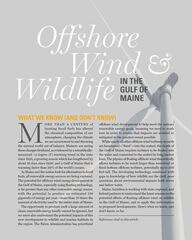
Return to flip book view
Offshore Wind Wildlife IN THE GULF OF MAINE WHAT WE KNOW AND DON T KNOW M ORE THAN A CENTURY of burning fossil fuels has altered the chemical composition of our atmosphere changing the climate we are accustomed to and throwing the natural world out of balance Mainers are seeing these changes firsthand as evidenced by a scientificallymeasured 3 degree F warming trend in the state since 1895 a growing season which has lengthened by about 16 days since 1950 and a Gulf of Maine that is warming faster than 99 of the world s oceans As Maine and the nation look for alternatives to fossil fuels all renewable energy sources are being explored The potential for offshore wind energy development in the Gulf of Maine especially using floating technology is far greater than any other renewable energy source with the potential to produce an estimated 156 gigawatts of energy per year more than 70 times the amount of electricity used by the entire state of Maine The opportunity to produce such a large amount of clean renewable energy locally cannot be ignored but we must also understand the potential impacts of this new development to wildlife and marine habitats in the region The Biden Administration has prioritized offshore wind development to help meet the nation s renewable energy goals meaning we need to work now in order to ensure that impacts are avoided or mitigated to the greatest extent possible While nearly all other offshore wind turbines on earth are hammered fixed into the seabed the depth of the Gulf of Maine requires turbines to be floated into the water and connected to the seabed by long anchor lines The physics of floating offshore wind theoretically allows turbines to be much larger than terrestrial or fixed bottom offshore turbines potentially up to 500 feet tall The developing technology combined with gaps in knowledge of how wildlife use the Gulf pose questions about environmental impacts both above and below water Maine Audubon is working with state regional and federal partners to understand the latest science on the potential effects of floating offshore wind on wildlife in the Gulf of Maine and to apply this information to proposed developments Here s what we know and don t know so far References cited in this article
OFFSHORE WIND & WILDLIFE IN THE GULF OF MAINEWhat We Know (and Don't Know) and What We Must Do SEABIRDS FISH & LOBSTER
MIGRATORY BIRDS & BATS WHALES & OTHER MARINE MAMMALS
ADVOCATING FOR Offshore Wind Wildlife Maine Audubon is committed to advocating for wildlife as Maine and the U S pursue a clean energy future We are active on a number of fronts and involved in key processes that will determine where and how floating offshore wind may occur in the Gulf including SUPPORTING THE PROPOSED GULF OF MAINE FLOATING OFFSHORE WIND RESEARCH ARRAY The State of Maine is pursuing the development of an up to 12 turbine research array in federal waters off Maine s coast Information from this array will allow the state the fishing industry wildlife advocates and other stakeholders to better understand the potential impacts of floating offshore wind in the Gulf of Maine This information will be used to responsibly site and operate future commercial offshore wind projects in the Gulf ENGAGING IN BUREAU OF OCEAN ENERGY MANAGEMENT BOEM DECISION MAKING BOEM is the federal agency that facilitates offshore wind development on the Outer Continental Shelf including granting leases to wind developers Locating lease areas in places that avoid areas that are critical to wildlife is the leading mitigation strategy Maine Audubon has worked for years to encourage BOEM to continue study of wildlife impacts in the Gulf Most recently we worked with state and national partners to advise BOEM on locations to avoid in the Gulf of Maine as well as other strategies to minimize impacts to wildlife UTILIZING STATE POLICY LEVERS The State of Maine can play a key role in guiding offshore wind development in the Gulf if the right policies are in place and resources are brought to bear Maine Audubon is advocating for the use of power purchase agreements for example to guide best development practices as well as establishing compensation mechanisms to account for unavoidable impacts Maine also needs to continue to commit state resources both money and people power to best understand the impact of offshore wind on wildlife Maine has a unique opportunity to lead in developing well sited and operated floating offshore wind with the least impact to wildlife and the environment This opportunity will only be realized with robust advocacy
References
Questions?
Join us for a free informational webinar
December 16, at noon.